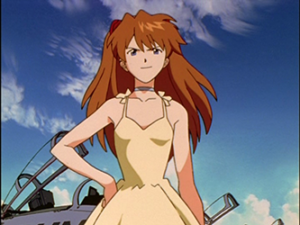A guest post by Peter Clampton.
Every now and again there comes a landmark work so monumental that its influence and popularity transcends superlatives. “Genre defying, masterpiece, jaw-dropping…” all have been used to describe works that takes a business or line media and catapult that into mainstream success. For books in the early 21st century, this was Harry Potter. For the once obscure and nerd riddled industry of Japanese anime of the late 1990’s, it was “Neon Genesis Evangelion.”
It is a hotly debated topic about where precisely this anime ranks in the top anime of all time, but there is no question that it belongs in the conversation. Its premise; children driving giant robots to save the world from an invading enemy. A deceptively simple, yet perfect backdrop to tell the story of the greatest battle of human existence; the battle with oneself.
Highlighting this battle is a vibrant and harrowingly disturbed cast of characters, one of which stands highest on the platform to not only display the competitive and glorious spirit that is human pride, but also the weakness found in its soft underbelly.
Enter Asuka Langley Soryu.

Rated by Newtype Magazine as the third most popular anime female of the 1990’s (Beaten only by her Evangelion counterpart, Rei Ayanami and Sailor Moon), it doesn’t take too long to see why Asuka is so memorable. Although she is introduced eight episodes into the twenty six episode series, she instantly makes a splash(literally) with astounding heroics defeating a giant sea creature in her giant robot, using battleships as stepping stones, which would become one of the most memorable anime action scenes of all time. Her red hair, and red themed attire is entirely indicative of her flamboyant personality, and her pride. Perfect material to add for a shake up!
Evangelion starts dour, subdued and builds a platform for reflective interactions and imaginative mecha battles. Early on, the main characters, Shinji and Rei, are emotionally scarred, quiet, and passive participants who pilot for the sake of others. We see the task of piloting an Evangelion as a hardship and sacrifice. Then enters Asuka who not only wants to pilot her Evangelion, but defines herself through her capacity and ability to do so.
This juxtaposition of Asuka compared with the rest of the cast and direction of the story serves up a smorgasbord of interesting scenes that not only illuminate Asuka’s intense personality, but the rest of the cast as well. This shake up of mood and tone for episodes 8 and 9 shifts the tone and direction of the series from dire and complex to comedic and outrageous, further highlighting the introduction of Asuka and her impact.
But Asuka is no cheap trope, used to simply spice things up, but is an intentional and deliberate presence bringing her own history, strengths and weaknesses to the story. She enhances the series, and better enables NGE to highlight the very thing at the core of its story; human interaction.
The scenes when she is alone with other characters-markedly Shinji the main character- we see her personality for what it is. A wall to protect a scarred and insecure teenage girl who in reality just wants to be loved. Yuko Miyamura the original Japanese voice actress of Asuka put it best in her quote:
Just to let you know, Asuka wasn’t the most open-hearted character I’ve met. When I act Asuka’s part, I try to synchronize myself with her 400%. But every time I tried to draw myself in closer synchronization, Asuka would never allow herself to synch with me. Even in the end, she would never step across the line and draw closer to me. One day, I figured out that there was a wall in Asuka’s heart.
 A wall that comes crumbling down when events in battle leave Asuka psychologically wrecked and unable to pilot her Evangelion. It is now we see the powerful and prideful Asuka deal with her very real and profound problems like any child would. Self-medicating in isolation and video games, unable to cope with the loss of the one thing that gave her life meaning. Resulting in further alienating herself from the one thing she needs most; other people.
A wall that comes crumbling down when events in battle leave Asuka psychologically wrecked and unable to pilot her Evangelion. It is now we see the powerful and prideful Asuka deal with her very real and profound problems like any child would. Self-medicating in isolation and video games, unable to cope with the loss of the one thing that gave her life meaning. Resulting in further alienating herself from the one thing she needs most; other people.
It is in this response I came to love Asuka. Because we are not shown just another anime character, or cookie cutter A-type, but a real person. A real and raw character whose pride and mental sickness come rushing to the forefront shattering all her self-deceptions, and her dreams. A girl who wants to be the best, but doesn’t want to be alone either. Asuka wasn’t made to be likable or hated, just a real teenage girl, who when honestly confronted with their shortcomings, was truly human. It was this slick and honest characterization and the psycho analysis of Asuka and others that would make Evangelion legendary.
Have you ever known a friend who was so complicated, and didn’t make any sense until you went into their home and saw how they lived? They might be angry or repressed, prideful and arrogant, but when you catch them in their vulnerability you begin to see parts of yourself in them? That’s what Asuka did for me. It was the first time I had ever watched anything that tackled the issues of the growing teenage mind in an honest and visual way, how could it not be memorable?
Even though she graduated college at thirteen, and could pilot a supremely powerful robot, we see that in Asuka the strengths of her personality and “confidence” and her weakness of emotional distance, were all a condition of her mind. The lessons I learned from Asuka and others from Evangelion are what endear me to them. My lesson from Asuka: that both victory and defeat can only be found within ourselves.
This is why I write. This is what makes great characters. Memorable characters are made from what they leave behind. In the end Asuka will always be memorable because underneath the red hair, and fiery personality beats a heart and soul of relentless complexity and truth.
Asuka Langley Soryu is as flawlessly flawed a human being ever portrayed in any medium and for that I, will always remember her as an iconic center to an iconic franchise that changed my life.

If you haven’t seen Evangelion, do yourself a favor and check it out. It won’t disappoint.
~Till next time
Stay Happy,
Stay Healthy
Peter Clampton

Peter Clampton is an author, a dreamer and most importantly a man with a vision. It’s a simple vision really. He is working to become a great story teller and hopes to share light through stories and enable others to do the same. He is Author of the Post-apocalyptic Western series THE GIRL AND THE BEAST which can be viewed, along with his other fiction, on his website
www.Peterclampton.com
 The film StarDust has everything a story needs to thrive in the hearts of dreamers. There’s the hero- Tristan Thorn, the villains: the three witches and an evil Prince. A goal- to catch a falling star and a wonderful message that the process of growth can happen only when you decide to be yourself.
The film StarDust has everything a story needs to thrive in the hearts of dreamers. There’s the hero- Tristan Thorn, the villains: the three witches and an evil Prince. A goal- to catch a falling star and a wonderful message that the process of growth can happen only when you decide to be yourself. Sarah Golden is a creative writer who draws inspiration from fairytales and folklore all over the world. She is a Kingdom Hearts addict and now owns her own keyblade! She is also a proud tour guide of Beast’s Castle at Magic Kingdom. With a Bachelor’s degree in English, Sarah hopes to share great stories through the written word and inspire others to be the heroes of their own story. She has written her first novel, and she is currently on a quest to publish it. Most of her other writing can be found on her blog Bara Lotus Garden: http://crystallizedheart.blogspot.com
Sarah Golden is a creative writer who draws inspiration from fairytales and folklore all over the world. She is a Kingdom Hearts addict and now owns her own keyblade! She is also a proud tour guide of Beast’s Castle at Magic Kingdom. With a Bachelor’s degree in English, Sarah hopes to share great stories through the written word and inspire others to be the heroes of their own story. She has written her first novel, and she is currently on a quest to publish it. Most of her other writing can be found on her blog Bara Lotus Garden: http://crystallizedheart.blogspot.com







